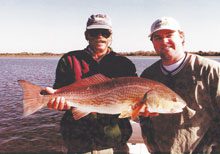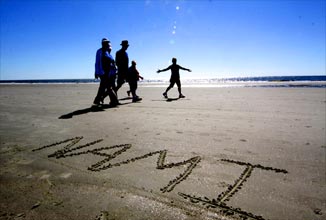 I agree with the person who said the best time to go fishing is when you can. However, here in the Lowcountry my favorite best time to go fishing is the fall. And it’s right around the corner, from about mid-September through at least early December.
I agree with the person who said the best time to go fishing is when you can. However, here in the Lowcountry my favorite best time to go fishing is the fall. And it’s right around the corner, from about mid-September through at least early December.
The fall is such a comfortable season, with the heat and humidity not entirely absent but with at least a strong hint that the sauna-like conditions of July and August are well on their way out. The air begins to feel slightly cooler and just a little drier, visibility gets a little longer, the marsh grass still holds its bright green of summer and the colors and contrasts become sharper. As the fall progresses we get the bonus of seasonal changes. Not a sudden, harsh Montana-like blast of winter but a much gentler, mostly visual transition as marsh grasses and deciduous trees put on their dormant uniforms while temperatures remain mild. Light layering is all we need with the cool nights and pleasantly warm days. Any breeze this time of year is usually short lived, being associated with brief, passing fronts and not at all persistent like the typical winds of early spring. And I’m immensely grateful that it’s still way too soon for even the lightest coat of frost on the deck.
And then, of course, there’s the fishing. Keep in mind I’m not talking about just any fishing. I’m talking about fly fishing in the inshore salt waters around Beaufort. More specifically I mean the myriad of creeks and rivers among the marshes and barrier islands from about the middle of Hilton Head Island to about the middle of Edisto Island. This estuary extends inland as far as far as10 miles and forms about 150 square miles of prime habitat for red drum, aka spot tail bass, redfish or just “reds”. Reds are an ideal fly fisher’s quarry.
These inshore waters become stuffed with shrimp during the fall, so the reds feed voraciously, sometimes rather recklessly with a “get it while the gettin’s good” attitude. This season offers the best chance that you may luck into one of those dream come truefly fishing days:
A towering cumulus cloud, mostly snow white with a little pink shading to grey and charcoal is billowing up toward the eastern horizon, far out somewhere over the Atlantic Ocean. When the sun is well up a shaft of sunlight drills through a hole in the clouds like a movie projector and a small area of the mostly shaded marsh grass lights up like a neon sign. The colors are brilliant against the softest, gentlest blue sky toward the opposite horizon. The wind has gone dead calm. The water is like a mirror. It’s reflecting this scene as far as you can see.
You’re positioned over the outer edge of a mud flat in about four or five feet of water at about the mid-point of ebb tide, a modest tide on the first or last quarter of the moon. Easily holding the boat in the gentle tidal current you notice a patch of nervous water, a section of otherwise mirror flat water that’s just started jiggling a little for no apparent reason. It’s some distance, maybe three hundred feet or more upstream. Then a few gulls and terns gather over the nervous patch of water, circling, hovering, and occasionally dipping down to the surface. The patch of nervous water is moving.
It’s a school of reds. They’re prowling the flat, in water so shallow it reveals every move they make, their dorsal fins occasionally and only briefly cutting sharp v-wakes. They’ve found a pod of shrimp which scatter in all directions, some flipping into the air with the reds in pursuit, backs half out of the water. The reds are getting the lion’s share of the shrimp. The terns are there to get their share. You’re there to get yours. And you can if you play it right.
But first you have to pinch yourself. No, you’re not dreaming. Indeed, it’s a dream come true.
As the guide or your fishing buddy quietly poles the shallow draft boat to intercept the school you both must avoid movements that rock the boat. That will displace a heavy wave across the shallow flat much like the water is pushed by bottle nose dolphin. That’s the reds’ primary predator and they will run for their lives.
Check the fly line you’ve already pulled from the reel and coiled on the deck to ensure it is tangle free and you’re not standing on it. It’s best to be barefoot (with sunscreen) or to wear special lightweight stocking-like slippers that allow you to feel the line on the deck.
The intercept point should be where the school will pass beside the boat within casting range. In this scenario (dead calm conditions) that should be no closer than 60 to 80 feet. If the reds are still actively feeding when they come within range it’s your double lucky day for they won’t be too sensitive to what’s going on nearby. With no more than three or four smooth false casts, keeping a low profile as dictated by sun angle and shadows and all the while not rocking the boat, aim the cast into and near the edge of an actively feeding school. Let it sink for a few seconds and then retrieve it in short, quick motions mimicking a fleeing shrimp. Be ready. Even in this shallow water these little rascals will be anywhere from one to three feet long
If there’s no take, lift about 35 feet of line for a back cast, change direction as needed and try another presentation, again being careful not to rock the boat or create a shadow. If you can still see the school but they are no longer actively feeding they can be a lot touchier, so you can’t cast too close. You’ve got to lead them. We call it sight casting, but in this case don’t look at the fish when you cast; look at your target, which is not where the fish are but where they’re going to be. Depending on their speed, the current and sun angle the target may need to be 15 to 20 feet or more in front of them.
It can be quite a challenge. We don’t always catch them. If we catch a few it’s a bonus. Lucky for us, redfish don’t live in ugly places.
Tight lines,
Dave Murray
Dave Murray helped pioneer salt water fly fishing in the Lowcountry. He is a retired Orvis endorsed guide and currently teaches Orvis and Bay Street Outfitters’ fly fishing schools. He lives in Beaufort with his wife, Terry. He can be reached at davemurray1033@gmail.com








